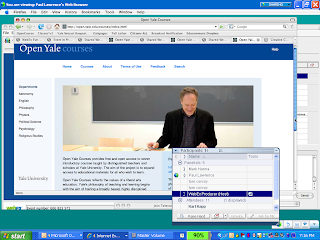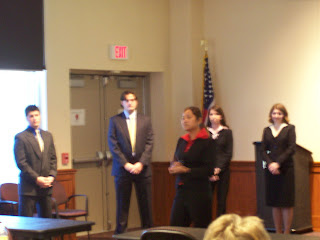
Happy Holidays to all, I'm taking a few days off this holiday season and will be blogging again in the new year!
__
Recommended Games and Gadgets
Recommended Books
Content Guide
This blog discusses issues concerning learning, e-learning and the transferring knowledge from retiring baby boomers to incoming gamers. The goal is to share information and knowledge to create a better understanding of learning design. ~ Blog Content Guide ~ Subscribe to this Blog ~ My Home Page

 Tony O'Driscoll explaining his "Seven Sensibilities of 3D Worlds" in Second Life class on MSIT Island.
Tony O'Driscoll explaining his "Seven Sensibilities of 3D Worlds" in Second Life class on MSIT Island. The folks over at Enspire have created a wonderful holiday greeting. You really need to check out the animated story How the Finch Stole E-Learning. It will bring a smile to your face.
The folks over at Enspire have created a wonderful holiday greeting. You really need to check out the animated story How the Finch Stole E-Learning. It will bring a smile to your face. Thanks to Cammy Bean for pointing this out. And thanks to Bjorn Billhardt, Stephen Robinson and the whole gang at Enspire for a little holiday cheer and laughter!
Thanks to Cammy Bean for pointing this out. And thanks to Bjorn Billhardt, Stephen Robinson and the whole gang at Enspire for a little holiday cheer and laughter!
Geek Brief TV is a 3-5 minute video podcast, released 4-5 times a week. We cover news about technology, consumer electronics, and Web 2.0 projects. We’ve gotten a lot of requests to make the Briefs longer than five minutes. So why don’t we? Our goal with Geek Brief is to keep people up to date on what’s happening in technology without investing a lot of time to do it. We don’t think technology should be boring, and we have a lot of fun producing Geek Brief.Watch a few episodes to become enlightened about technology and then watch a few episodes to figure out how to adapt this model to your own internal training. It might be a lot better than creating sporadic 12 minute or 20 minute videos which people tune out after a short time anyway. And a little learning, administered a couple times a week might go a lot further than dumping information onto an employee all at once.

[This book, like others, talks about] the impending retirement of baby boomers and how companies are dealing with the critical knowledge transfer that needs to take place.
But what makes this book different is its unique approach to the knowledge-transfer issue...This book is a valuable resource for any business looking to find practical solutions to the boomer-gamer knowledge-transfer gap. It reveals new methods and tools that are being used successfully in a variety of settings, including Flash mobs and cheat codes, video iPods, instant messaging and blogging.

 A while back I had a discussion with Cammy Bean of Learning Visions about what level of "gamer" she was and even if she was a gamer at all. No resolution was ever reached but her post Are You a Gamer? generated many comments.
A while back I had a discussion with Cammy Bean of Learning Visions about what level of "gamer" she was and even if she was a gamer at all. No resolution was ever reached but her post Are You a Gamer? generated many comments.
The project, called “Open Yale Courses,” presents unique access to the full content of a selection of college-level courses and makes them available in various formats, including downloadable and streaming video, audio only and searchable transcripts of each lecture. Syllabi, reading assignments, problem sets and other materials accompany the courses.
Diana E. E. Kleiner, Dunham Professor of the History of Art and Classics and the director of the project, noted that the full content of all the courses is now readily available online and may be accessed at the users’ convenience.
“We wanted everyone to be able to see and hear each lecture as if they were sitting in the classroom,” Kleiner said. “It’s exciting to make these thought-provoking courses available so broadly for free. While education is best built upon direct interactions between teachers and students, Yale believes that leading universities have much to contribute to making educational resources accessible to a wider audience. We hope this ongoing project will benefit countless people around the world
 The tape of my television appearance on CBS affiliate WYOU is now available, courtesy of WYOU with editing assistance from Matt Monahan. You can view a large screen or small screen version. The tape starts with some "man on the street" interviews, some info about e-learning, an exchange between the anchor and weather man and then goes into the interview.
The tape of my television appearance on CBS affiliate WYOU is now available, courtesy of WYOU with editing assistance from Matt Monahan. You can view a large screen or small screen version. The tape starts with some "man on the street" interviews, some info about e-learning, an exchange between the anchor and weather man and then goes into the interview. 
I read your article in the Daily Item today and I thought it was great. I am a teacher at [a local school] and I am a big supporter of bringing technology into the classroom. I hope that your article will speak to those teachers that are reluctant to see technology, especially video games, as a hindrance to education. I think that games and many other forms of technology could enhance education and make school much more enjoyable, especially for students who would rather not be here. While I did not write a book on the subject I did do a paper on it this fall and used some of the same examples and sources that you used. Thank you again for all you are doing by helping people understand the benefits of technology

All those flailing arms can sometimes inadvertently smack into lamps, furniture and even competing players.So keep away from others.
EyeToy: Kinetic™ is an innovative fitness product that provides players with an authentic personalized exercise program all in the comfort of their own home Utilizing the revolutionary EyeToy® USB Camera technology and developed in association with Nike Motionworks (experts in fitness, motion and body movement) players will experience a more effective workout inspired by activities such as Tai Chi, Kick Boxing, Aerobics, Yoga, Modern Dance and more.
Two unique personal trainers provide direction, real-time performance evaluations and encouragement as players of all fitness levels engage in a comprehensive 12-week training routine or select individual routines to shape and tone specific areas.
Wrapped in modern styling and supplemented with an energetic soundtrack, EyeToy: Kinetic is a fun and immersive fitness product like no other

 Their solution had the benefits of high interactivity between the user and a virtual doctor, instant proof of certification of new employees to sell products, the assessments were self-paced and the solution was provided by experienced experts in the field. The team members were Matthew Monahan, Sunita Adhikari, Steven Davis, Ruth Houck and Garrett Metz.
Their solution had the benefits of high interactivity between the user and a virtual doctor, instant proof of certification of new employees to sell products, the assessments were self-paced and the solution was provided by experienced experts in the field. The team members were Matthew Monahan, Sunita Adhikari, Steven Davis, Ruth Houck and Garrett Metz.  The solution they proposed was based on a system they had developed called PACES-Personal Assessment and Certification E-Learning System. Their solution consisted of a series of quizzes leading to both the knowledge and behavioral assessments. The team consisted of Stan Yann, Jennifer Cerreta, Nicolas Hanhan, Aman Tyagi and Lance Collier.
The solution they proposed was based on a system they had developed called PACES-Personal Assessment and Certification E-Learning System. Their solution consisted of a series of quizzes leading to both the knowledge and behavioral assessments. The team consisted of Stan Yann, Jennifer Cerreta, Nicolas Hanhan, Aman Tyagi and Lance Collier.  eJewel's solution consisted of two parts. The first was subdivided into three multiple choice knowledge assessments in teh areas of physiology, human anatomy and various mechanism of action for pain relief. The second was an interactive role playing activity that assessed employee selling skills such as building credibility and other assessment items. eJewel was the overall winner of the exercise. The team consisted of Chase Winters, Danny Collins, Kate Krasnokutska, Mach Meas, and Melanie Campbell.
eJewel's solution consisted of two parts. The first was subdivided into three multiple choice knowledge assessments in teh areas of physiology, human anatomy and various mechanism of action for pain relief. The second was an interactive role playing activity that assessed employee selling skills such as building credibility and other assessment items. eJewel was the overall winner of the exercise. The team consisted of Chase Winters, Danny Collins, Kate Krasnokutska, Mach Meas, and Melanie Campbell. 



 Next, we had a panel discussion called Working Collaboratively and Independently Simultaneously:Independent and Contractor and Small Business Forum. The panel consisted of Robyn Defelice, Jennifer Pearson, Brad Keller, Jonathan Jones and Phil Charron and had great information about being an independent contractor/consultant.
Next, we had a panel discussion called Working Collaboratively and Independently Simultaneously:Independent and Contractor and Small Business Forum. The panel consisted of Robyn Defelice, Jennifer Pearson, Brad Keller, Jonathan Jones and Phil Charron and had great information about being an independent contractor/consultant.  The discussion focused on non-compete agreements, intellectual property and other issues related to creating content and ideas for clients. The discussion also centered around how each person got started as a contractor.
The discussion focused on non-compete agreements, intellectual property and other issues related to creating content and ideas for clients. The discussion also centered around how each person got started as a contractor. 


 Cliff Sobel and Rhonda Dorsett presented on a companion website that The Phoenix Group created for the PBS television program "Travels to The Edge" hosted by well known photographer, Art Wolfe.
Cliff Sobel and Rhonda Dorsett presented on a companion website that The Phoenix Group created for the PBS television program "Travels to The Edge" hosted by well known photographer, Art Wolfe. 





Acrophobia is a multi-round, multiplayer online Internet Relay Chat game. The game was originally conceived by Anthony Shubert and programmed by Kenrick Mock (aka Mach) and Michelle Hoyle (aka Eingang) in 1995. Players enter a channel hosted by a bot which runs the game. In each round, the bot generates a random acronym. Players compete by racing to create the most coherent or humorous sentence or series of related words that fits the acronym - in essence, a backronym. After a set amount of time expires, each player then votes anonymously via the bot for their favorite answer (aside from their own).
Points are awarded to the most popular backronym. Bonus points may be also be given based on the fastest response and for voting for the winning option. Some implementations give the speed bonus to the player with the first answer that received at least one vote; this is to discourage players from quickly entering gibberish just to be the first. Bonus points for voting for the winner helps discourage players from intentionally voting for poor answers to avoid giving votes to answers that might beat their own.
Usually, nonsense backronyms will score low and the most humorous sounding backronym which effectively makes a sentence from the initials will win. Some rounds may have a specific topic that the answers should fit, although enforcement of the topic depends on solely on the other players' willingness to vote for off-topic answers
With a little modification, this game is a great way to teach acronyms to new employees. This internet game was originally created by Anthony Shubert in the mid-to late 1990s and incorporates a chat room, voting on other players’ answers and the element of speed.
The game play involves entering into a chat room and being presented with a series of randomly generated letters seen by all the players; for example ELO or MLAN. The players then type an acronym as quickly as possible matching those letters; perhaps Electric Light Orchestra or Enterprising Ladies Organization. After all the players submit their acronym and time has expired, the acronyms are displayed and the players vote for the best one. The winner is the acronym/definition combination with the most votes. During the game play, a chat box is available for the players to discuss the various acronyms and what they liked or didn’t like.
Now imagine this game with a few modifications for use as a training tool. Instead of randomly generated letters, the letters represent actual acronyms used in the organization. The players are new employees who compete with one another to see who recognizes the acronym the quickest. Instead of voting, the system determines the winner based on speed. The chat room is monitored by a veteran employee (boomer) who comments on the meaning of the acronym and how it is used within the organization. The gamers enjoy the game while learning acronyms used within the organization. Simultaneously they are mentored by a seasoned boomer monitoring the chat. Players don’t even have to be in the same building or state; they don’t even need to leave their desk.
Packed with geography and history, yet exciting enough to keep teen and adult players engaged for hours, Civilization III was, in many ways, already an educational game before Kurt Squire, an assistant professor of education technology at the University of Wisconsin-Madison, decided to try it out on groups of 11- to 15-year-olds at an inner-city Boston school. "You might think of it as a map in a history book come to life," Squire explains. Players choose a geographical region and develop it using only resources available 6,000 years ago. Slowly but surely, they obtain agriculture, architecture, knowledge. Trade routes are forged; diplomatic ties with other players are established. Civil unrest and natural disasters pose formidable challenges, as do invading forces from neighboring countries, especially when the invading force is also your playground nemesis.
Still, integrating a game designed to entertain adults into a classroom full of teenagers wasn't easy. In his study, Squire discovered that the advanced vocabulary and complicated rules frustrated students, while teachers struggled to manage 25 kids doing 25 things at the same time. Also, because Civilization III teaches the underlying principles behind history, rather than names and dates, it didn't do much to help teachers prepare students for testing. Although Squire says the teachers he worked with were overall very positive, he adds, "This is not something I would throw on unsuspecting teachers." Squire has since published curriculum support and is developing an online network to aid teachers who wish to use Civilization III in their own classrooms.
Games offer attributes important for learning—clear goals, lessons that can be practiced repeatedly until mastered, monitoring learner progress and adjusting instruction to learner level of mastery, closing the gap between what is learned and its use, motivation that encourages time on task, personalization of learning, and infinite patience.
